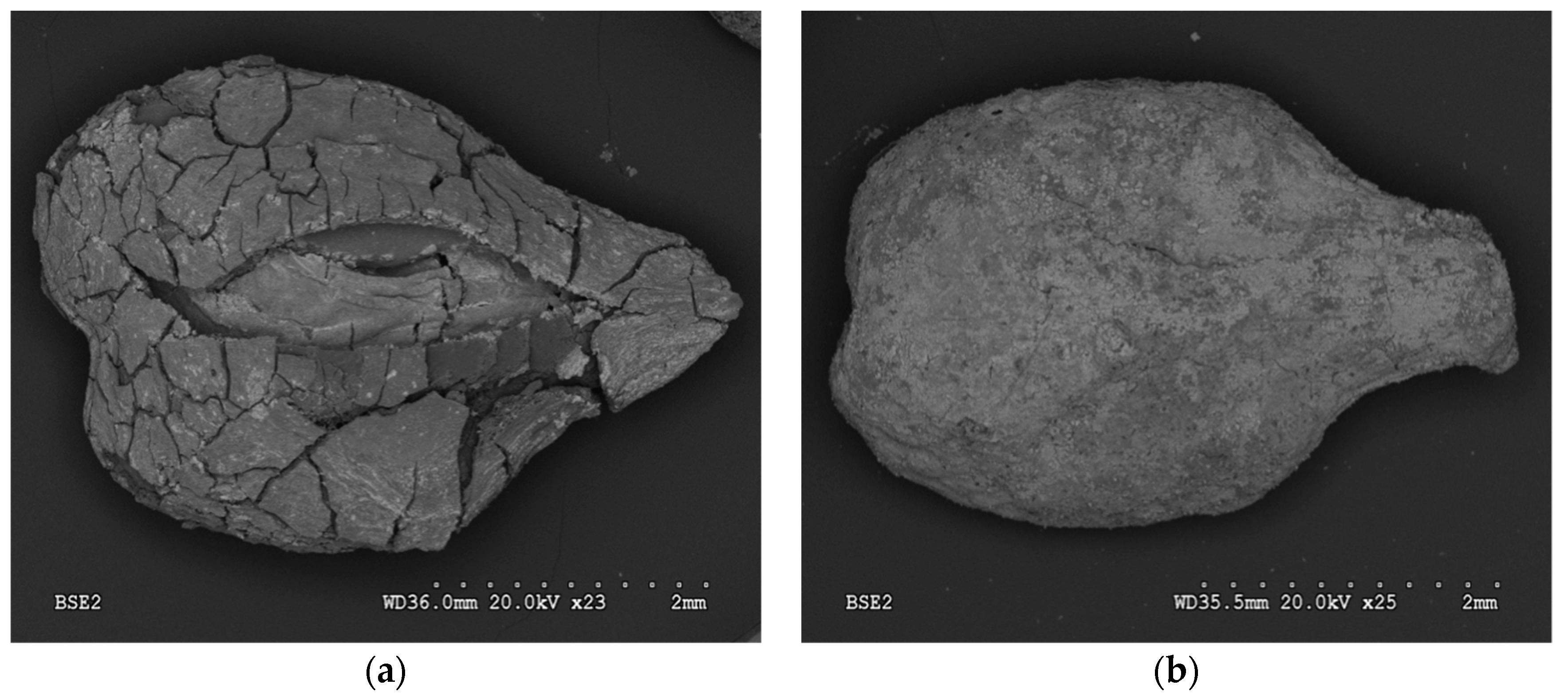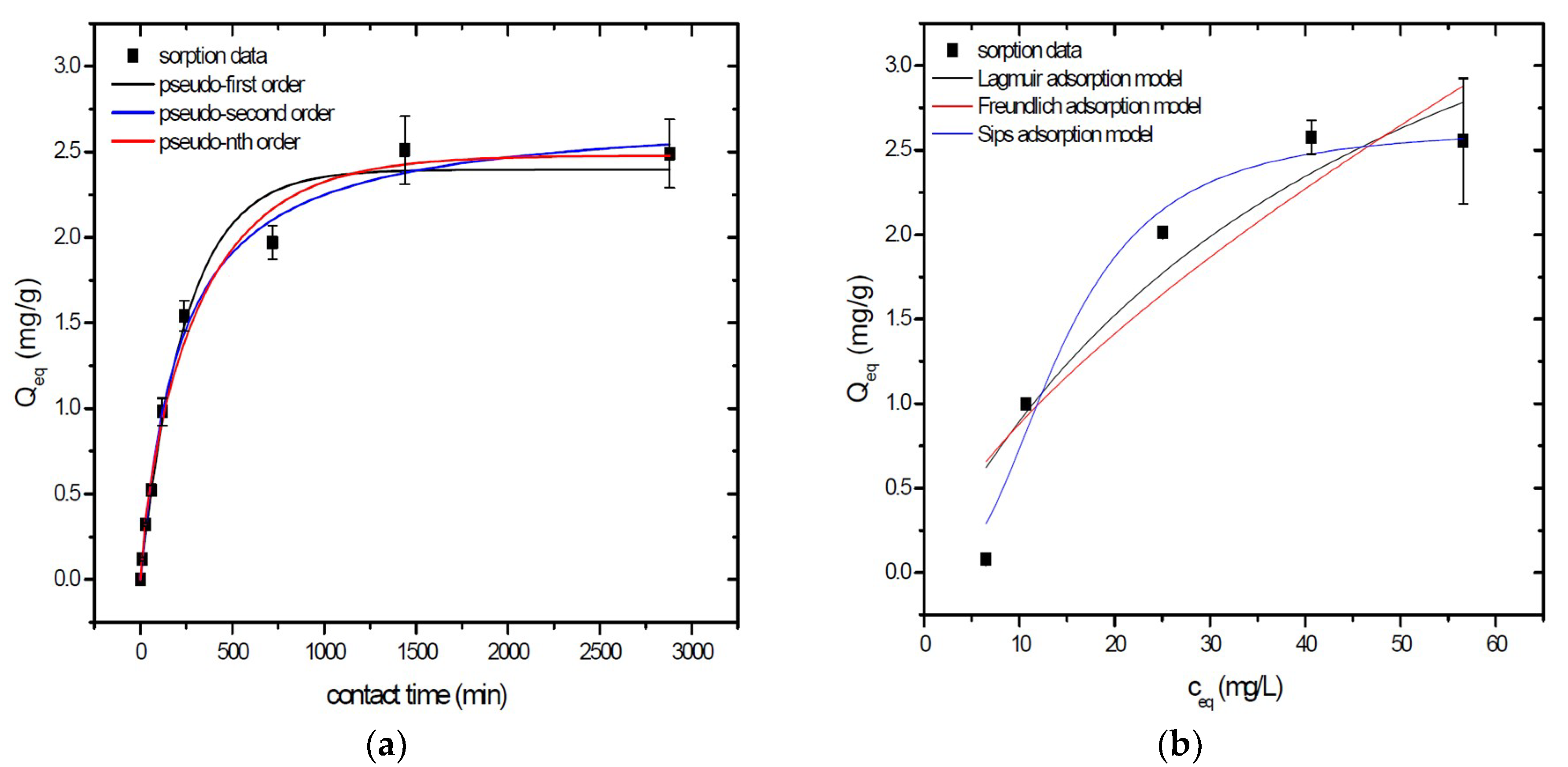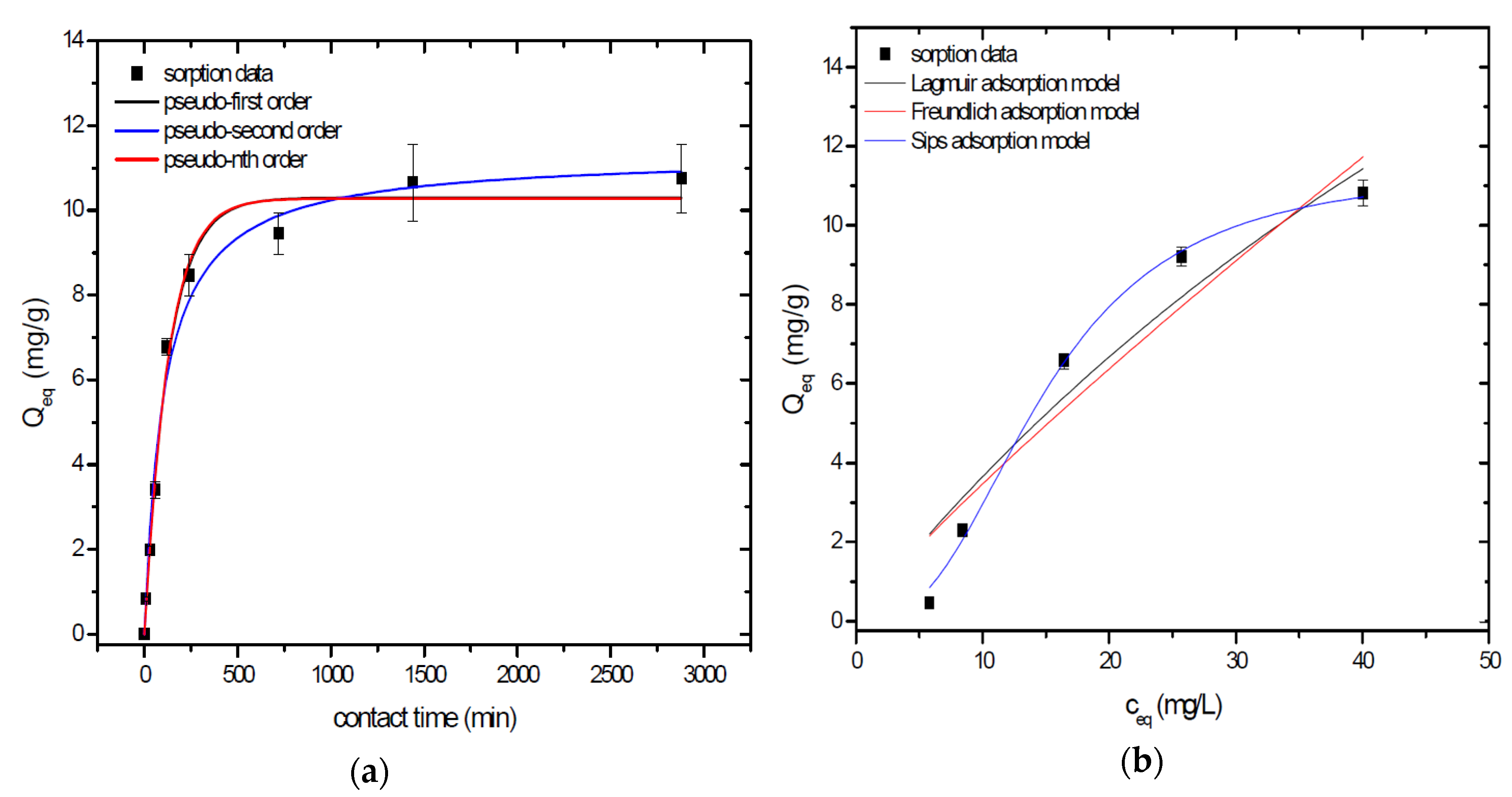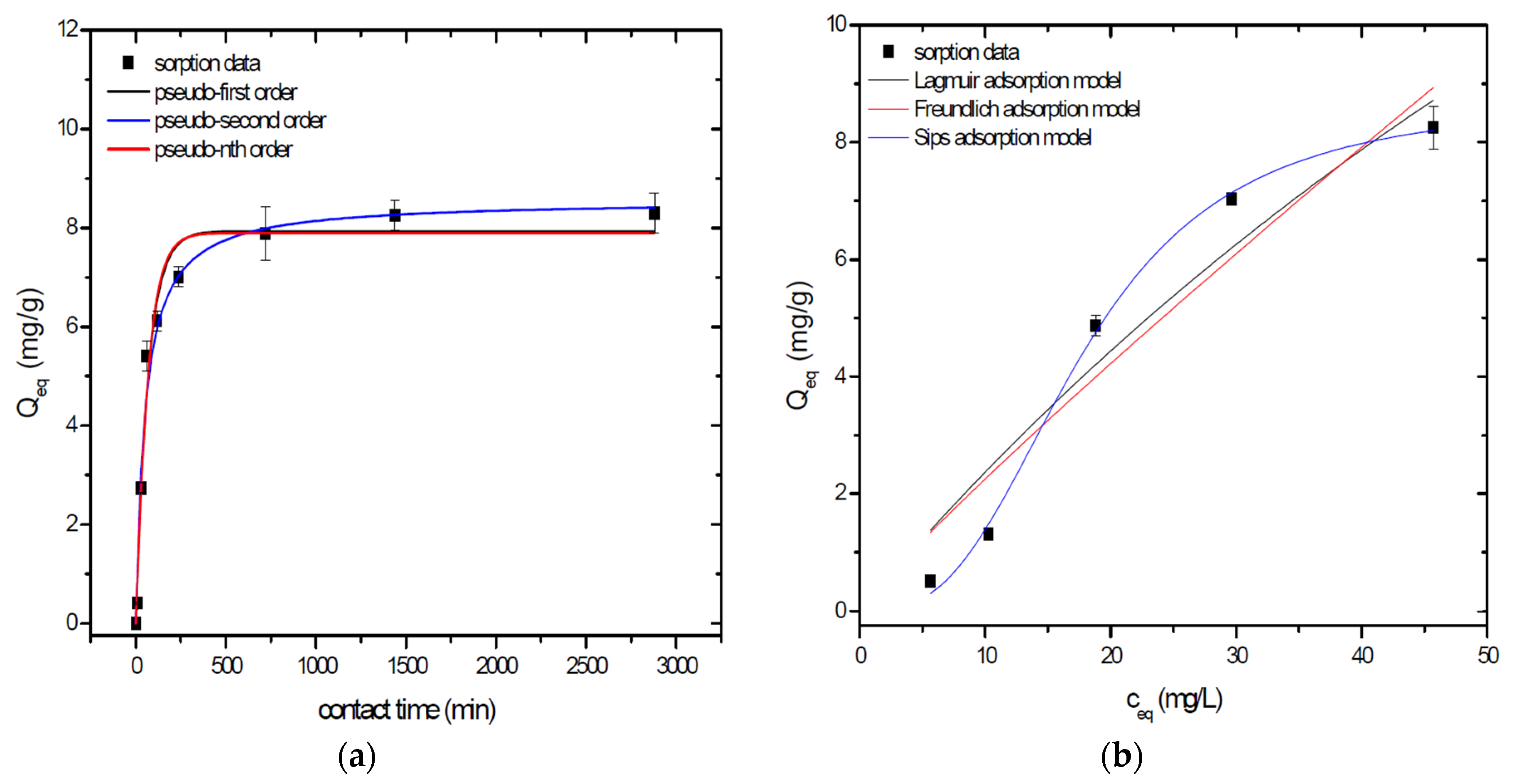Effect of Physical and Chemical Activation on Arsenic Sorption Separation by Grape Seeds-Derived Biochar
Abstract
:1. Introduction
2. Materials and Methods
2.1. Biochar Origin, Pyrolysis and Activation Process
2.2. Sorbent Characterization
2.3. Experimental Design of Sorption Experiments
2.3.1. Applied Mathematical Models of Kinetic Study
2.3.2. Applied Mathematical Models of Adsorption Isotherms
2.4. Sorbent Regeneration Study
3. Results
4. Conclusions
Author Contributions
Funding
Acknowledgments
Conflicts of Interest
References
- Tarvainen, T.; Albanese, S.; Birke, M.; Poňavič, M.; Reimann, C. The GEMAS Projet Team. Arsenic in agricultural and graying land soils of Europe. Appl. Geochem. 2013, 28, 2–10. [Google Scholar] [CrossRef]
- Mandal, S.; Sahu, M.K.; Patel, R.K. Adsorption studies of arsenic(III) removal from water by zirconium polyacrylamide hybrid material (ZrPACM-43). Water Resour. Ind. 2013, 4, 51–67. [Google Scholar] [CrossRef]
- Mohan, D.; Pittman, C.H.U. Arsenic removal from water/wastewater using adsorbents-Acritical review. J. Hazard. Mater. 2007, 142, 1–53. [Google Scholar] [CrossRef] [PubMed]
- Pipíška, M.; Micháleková-Richveisová, B.; Frišták, V.; Horník, M.; Remenárová, L.; Stiller, R.; Soja, G. Sorption separation of cobalt and cadmium by straw-derived biochar: Aradiometric study. J. Radioanal. Nucl. Chem. 2017, 311, 85–97. [Google Scholar] [CrossRef]
- Aranda, P.R.; Llorens, I.; Perino, E.; de Vito, I.; Raba, J. Removal of arsenic (V) ions from aqueous media by adsorption on multiwall carbon nanotubes thin film using XRF technique. Environ. Nanotechnol. Monit. Manag. 2016, 5, 21–26. [Google Scholar] [CrossRef]
- Shakoor, M.B.; Niazi, N.K.; Bibi, I.; Shahid, M.; Sharif, F.; Bashir, S.; Shaheen, S.M.; Wang, H.; Tsang, D.C.W.; Ok, Y.S.; et al. Arsenic removal by natural and chemically modified watermelon rind in aqueous solutions and groundwater. Sci. Total. Environ. 2018, 645, 1444–1455. [Google Scholar] [CrossRef] [PubMed]
- Sepúlveda, P.; Rubio, M.A.; Baltazar, S.E.; Rojas-Nunez, J.; Sánchez-Llamazares, J.L.; Garcia, A.G.; Arancibia-Miranda, N. As (V) removal capacity of Fe Cu bimetallic nanoparticles in aqueous solutions: The influence of Cu content and morphologic changes in bimetallic nanoparticles. J. Colloid Interface Sci. 2018, 524, 177–187. [Google Scholar] [CrossRef] [PubMed]
- Pan, H.; Hou, H.; Chen, J.; Li, H.; Wang, L. Adsorption of arsenic on iron modified attapulgite (Fe/ATP): Surface complexation model and DFT studies. Adsorption 2018, 24, 459–469. [Google Scholar] [CrossRef]
- Bakshi, S.; Banik, C.; Rathke, S.J.; Laird, D.A. Arsenic sorption on zero-valent iron-biochar complexes. Water Res. 2018, 137, 153–163. [Google Scholar] [CrossRef] [PubMed]
- Frišták, V.; Micháleková-Richveisová, M.; Víglašová, E.; Ďuriška, L.; Galamboš, M.; Moreno-Jimenéz, E.; Pipíška, M.; Soja, G. Sorption separation of Eu and As from single-component systems by Fe-modified biochar: Kinetic and equilibrium study. J. Iran. Chem. Soc. 2017, 14, 521–530. [Google Scholar] [CrossRef]
- Podder, M.S.; Majumder, C.B. Kinetic, mechanistic and thermodynamic studies of removal of arsenic using Bacillus arsenicus MTCC 4380 immobilized on surface of granular activated carbon/MnFe2O4 composite. Groundw. Sustain. Dev. 2016, 2–3, 53–72. [Google Scholar] [CrossRef]
- Micháleková-Richveisová, B.; Frišták, V.; Pipíška, M.; Ďuriška, L.; Moreno-Jimenéz, E.; Soja, G. Iron-impregnated biochars as effective phosphate sorption materials. Environ. Sci. Pollut. Res. 2017, 14, 521–530. [Google Scholar] [CrossRef] [PubMed]
- Lehmann, J.; Joseph, S. Biochar for Environmental Management: Science, Technology and Implementation; Earthscan from Routlenge: London, UK, 2015; ISBN 978-0-415-70415-1. [Google Scholar]
- Frišták, V.; Pipíška, M.; Soja, M. Pyrolysis treatment of sewage sludge: A promising way to produce phosphorus fertilizer. J. Clean Technol. 2018, 172, 1772–1778. [Google Scholar] [CrossRef]
- Azargohar, R.; Dalai, A.K. Steam and KOH activation of biochar: Experimental and modeling studies. Microporous Mesoporous Mater. 2008, 110, 413–421. [Google Scholar] [CrossRef]
- Frišták, V.; Friels-Hanl, W.; Pipíška, M.; Richveisová-Micháleková, B.; Soja, G. The response of artificial aging to sorption properties of biochar for potentially toxic heavy metals. Nova Biotechnologica et Chimica 2014, 13, 137–147. [Google Scholar] [CrossRef]
- Shim, T.; Yoo, J.; Ryu, Ch.; Park, Y.K.; Jung, J. Effect of steam activation of biochar produced from a giant Miscanthus on copper sorption and toxicity. Biores. Technol. 2015, 197, 85–90. [Google Scholar] [CrossRef] [PubMed]
- Mena, I.F.; Diaz, E.; Rodriquez, J.J.; Mohedano, A.F. CWPO of bisphenol A with iron catalysts supported on microporous carbons from grape seeds activation. Chem. Eng. J. 2017, 318, 153–160. [Google Scholar] [CrossRef]
- Enders, A.; Lehmann, J. Comparison of wet/digestion and dry-ashing methods for total elemental analysis of biochar. Commun. SoilSci. Plant. 2012, 43, 1042–1052. [Google Scholar] [CrossRef]
- OECD-Guideline 106. OECD Guideline for the Testing of Chemicals. Adsorption–Desorption Using a Batch Equilibrium Method; Organisation for Economic Co-operation and Development (OECD): Paris, France, 2001. [Google Scholar]
- Fiol, N.; Villaescusa, I.; Martínez, M.; Miralles, N.; Poch, J.; Serarols, J. Sorption on Ni (II), Cu (II) and Cd (II) from aqueous solution by olive stone waste. Sep. Purif. Technol. 2006, 50, 132–140. [Google Scholar] [CrossRef]
- Azizian, S.; Fallag, R.N. A new empirical rate equation for adsorption kinetics at solid/solution interface. Appl. Surf. Sci. 2010, 256, 5153–5156. [Google Scholar] [CrossRef]




| GS | GSBC | A1GSBC | A2GSBC | |
|---|---|---|---|---|
| C (wt %) | 55.8 | 81.8 | 73.8 | 69.0 |
| H (wt %) | 6.8 | 2.2 | 2.1 | 2.4 |
| N (wt %) | 2.3 | 1.9 | 2.6 | 3.1 |
| S (wt %) | n.d. 1 | n.d.1 | n.d. 1 | n.d. 1 |
| O (wt %) | 31.6 | 4.7 | 9.5 | 14.6 |
| Ash (%) | 3.5 | 9.4 | 12.0 | 10.9 |
| SA (m2/g) | 42 | 405 | 416 | 348 |
| Vmicropores (mL/g) | 0.01 | 0.14 | 0.15 | 0.12 |
| Fe (wt %) | n.d. 1 | n.d. 1 | 2.8 | 4.7 |
| As (wt%) | n.d. 1 | n.d. 1 | n.d. 1 | n.d. 1 |
| Pseudo-First Order Rate Constants | Pseudo-Second Order Rate Constants | Pseudo-Nth Order Rate Constants | |||||||
|---|---|---|---|---|---|---|---|---|---|
| Sorbent | Qeq (mg/g) | k1 (1/min) | COD | Qeq (mg/g) | k1 (g/mg min−1) | COD | Qeq (mg/g) | k1 (g/mg min−1) | COD |
| GSBC | 2.390 | 0.004 | 0.985 | 2.734 | 0.002 | 0.990 | 2.479 | 0.002 | 0.993 |
| A1GSBC | 10.301 | 0.008 | 0.990 | 11.313 | 0.001 | 0.987 | 10.277 | 0.009 | 0.992 |
| A2GSBC | 7.936 | 0.014 | 0.977 | 8.565 | 0.002 | 0.979 | 7.895 | 0.017 | 0.990 |
| Langmuir | Freundlich | Sips | ||||||||
|---|---|---|---|---|---|---|---|---|---|---|
| Sorbent | Qmax (mg/g) | B (L/mg) | COD | K (L/g) | n | COD | Qmax (mg/g) | B (L/mg) | n | COD |
| GSBC | 5.082 | 0.021 | 0.904 | 0.182 | 0.684 | 0.861 | 2.633 | 0.0008 | 2.656 | 0.979 |
| A1GSBC | 39.443 | 0.007 | 0.928 | 0.457 | 0.907 | 0.916 | 11.438 | 0.0002 | 2.927 | 0.998 |
| A2GSBC | 34.903 | 0.010 | 9.923 | 0.287 | 0.879 | 0.907 | 8.706 | 0.0006 | 2.706 | 0.994 |
| Desorption Agent | Sorbent | Qeq (mg/g) in Each Number of Sorption-Desorption Cycle | |||||||||
|---|---|---|---|---|---|---|---|---|---|---|---|
| 1 | 2 | 3 | 4 | 5 | |||||||
| S | D | S | D | S | D | S | D | S | D | ||
| HNO3 | GSBC | 2.5 *** | 1.8 *** (72%) | 2.0 *** | 1.5 *** (75%) | 1.4 * | 1.0 * (71%) | 0.6 *** | 0.2 *** (33%) | n.d. | n.d |
| A1GSBC | 10.7 *** | 8.6 *** (80%) | 5.2 * | 3.2 *** (62%) | 3.1 *** | 0.8 * (26%) | n.d. | n.d | n.d. | n.d | |
| A2GSBC | 8.2 *** | 5.4 *** (66%) | 4.7 | 2.6 *** (55%) | 1.3 * | 0.4 *** (31%) | n.d. | n.d | n.d. | n.d | |
| NaOH | GSBC | 2.5 *** | 1.9 *** (76%) | 2.4 *** | 2.3 *** (85%) | 2.3 *** | 2.3 *** (100%) | 2.4 *** | 1.8 *** (75%) | 2.0 *** | 1.4 *** (70%) |
| A1GSBC | 10.8 *** | 10.7 *** (99%) | 10.7 *** | 10.4 *** (97%) | 10.1 *** | 9.4 *** (93%) | 9.5 *** | 8.7 *** (92%) | 9.4 *** | 8.4 *** (89%) | |
| A2GSBC | 8.1 *** | 7.8 *** (96%) | 7.9 *** | 7.6 *** (96%) | 7.9 *** | 7.3 *** (92%) | 7.0 *** | 6.8 *** (97%) | 5.7 *** | 5.1 *** (89%) | |
© 2018 by the authors. Licensee MDPI, Basel, Switzerland. This article is an open access article distributed under the terms and conditions of the Creative Commons Attribution (CC BY) license (http://creativecommons.org/licenses/by/4.0/).
Share and Cite
Frišták, V.; Moreno-Jimenéz, E.; Fresno, T.; Diaz, E. Effect of Physical and Chemical Activation on Arsenic Sorption Separation by Grape Seeds-Derived Biochar. Separations 2018, 5, 59. https://doi.org/10.3390/separations5040059
Frišták V, Moreno-Jimenéz E, Fresno T, Diaz E. Effect of Physical and Chemical Activation on Arsenic Sorption Separation by Grape Seeds-Derived Biochar. Separations. 2018; 5(4):59. https://doi.org/10.3390/separations5040059
Chicago/Turabian StyleFrišták, Vladimír, Eduardo Moreno-Jimenéz, Teresa Fresno, and Elena Diaz. 2018. "Effect of Physical and Chemical Activation on Arsenic Sorption Separation by Grape Seeds-Derived Biochar" Separations 5, no. 4: 59. https://doi.org/10.3390/separations5040059
APA StyleFrišták, V., Moreno-Jimenéz, E., Fresno, T., & Diaz, E. (2018). Effect of Physical and Chemical Activation on Arsenic Sorption Separation by Grape Seeds-Derived Biochar. Separations, 5(4), 59. https://doi.org/10.3390/separations5040059







